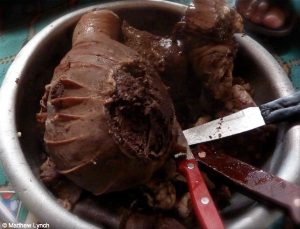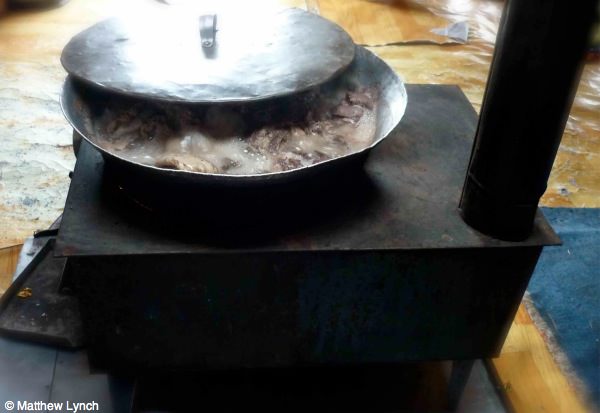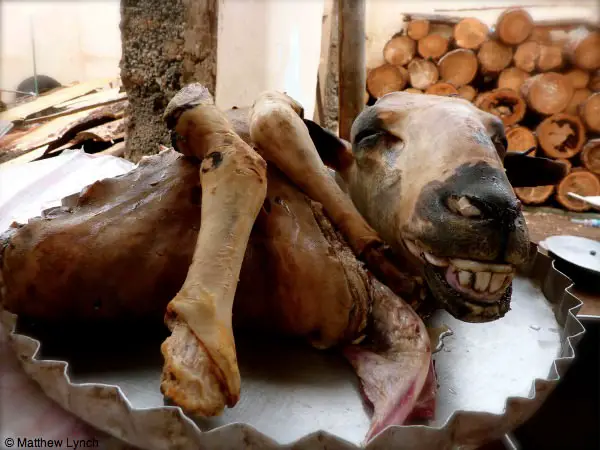Vegetarian’s survival guide to Mongolia
Vegetarians beware.
There may be plenty of vegetarian dining options in Ulaanbaatar, the capital city of Mongolia, but if you are planning a trip to Outer Mongolia, make it a short one. Or bring lots and lots of your own food supplies.
Let me take you to Tosontsengel, in Northwestern Outer Mongolia, where we are treated to an old-style Mongolian barbecue – “a feast for kings”.
The sheep is slaughtered using the traditional technique – I’ll spare you the gory details here, but just picture that scene from Indiana Jones and the Temple of Doom, and you’ll get the picture.
First course
First course is a rich mutton broth made from the water in which the internal organs have been boiling away for the last three hours.
Second course
 Second course, you guessed it, the organs are presented to the guests of honour first – slopped into a steel bowl and placed at your feet with the handle of a large, sharp knife that has been made for meat-eating pointed in your direction. Dive in and carve off a piece of lung, kidney, or heart for your dining pleasure.
Second course, you guessed it, the organs are presented to the guests of honour first – slopped into a steel bowl and placed at your feet with the handle of a large, sharp knife that has been made for meat-eating pointed in your direction. Dive in and carve off a piece of lung, kidney, or heart for your dining pleasure.
The organs are the most nutritious, and therefore the most highly prized part of the animal. Mongolia freezes over during their long, harsh winters, and the nomadic herding lifestyle has evolved in response to act as a family’s energy store through the cold months; hence Mongolians’ love of meat, meat, and more meat.
Third course
Third course? Another version of mutton broth, to cleanse your palate – this one richer than the first, if that is possible, made from the water the rest of the carcass has been simmering in for the last three hours.
 Don’t forget the condiments! Pickled green tomatoes, potent wild onions, zesty pickled beetroot, and perhaps some baby boiled potatoes. Mongolia’s growing season is short, and conditions harsh (you try growing vegetables in the Gobi Desert), so if you are lucky enough to be served veggies in the countryside then know that you are truly being treated as royalty.
Don’t forget the condiments! Pickled green tomatoes, potent wild onions, zesty pickled beetroot, and perhaps some baby boiled potatoes. Mongolia’s growing season is short, and conditions harsh (you try growing vegetables in the Gobi Desert), so if you are lucky enough to be served veggies in the countryside then know that you are truly being treated as royalty.
Fourth course
Thankfully, the fourth course is not a boiled carcass – rather, more recognisable cuts of meat served up in another bowl with more knife handles pointed at your belly so that you can hack a chunk of meat from the bone you’ve picked. Wipe the grease from your hands on a leather bridle, which is passed around the yurt; clean your hands and keep your hosts’ riding equipment soft and supple at the same time!
Take another sip of the traditional, ubiquitous salty milk tea called ‘tsu te tse’, and brace yourself for the next course. Milk is another highly nutritious product of the nomads’ animal herds, and is preserved by making it into cheeses and yoghurts; diluting milk in tea is another way to stretch this precious resource further.
Fifth course
 The fifth course you will not have seen before: the boiled sheep’s stomach, bulging with its mystery contents, is presented on a platter. Your host produces his knife with a flourish, and deftly opens the sac to reveal… the sheep’s head, whose lips have been drawn back into a macabre smile when its hair was singed off in preparation for your meal.
The fifth course you will not have seen before: the boiled sheep’s stomach, bulging with its mystery contents, is presented on a platter. Your host produces his knife with a flourish, and deftly opens the sac to reveal… the sheep’s head, whose lips have been drawn back into a macabre smile when its hair was singed off in preparation for your meal.
A couple more deft slices of his knife, and the tripe bag opens to reveal the sheep’s shins and hooves, which have also been singed, and stuffed in along with the happy head, whose jaw now drops open with a dull thud, turning its grin into a toothy guffaw.
But wait, there’s more! The fatty tail pad has been scooped out, filled with minced meat, sewn shut and boiled next to the stuffed stomach for the last three hours – it is this part that was considered to be Ghengis’s favorite meal – A Feast Fit For The Khan.
Vegetarian survival guide to Mongolia:
- 1. Cling to the first piece of meat offered to you and nurse it through your entire meal. If you pick this bone clean your hosts will only offer you more.
- 2. Hold your breath when sipping the organ stew. Have some bottled water or fruit juice nearby in your canteen to wash the taste out of your mouth.
- 3. Beam with delight when offered pickled veggies or (on the very rare occasion) green salad to encourage your host to offer you more.
- 4. Sit next to a friendly carnivore whom you can offload your meat dishes on to when nobody is looking.
- 5. Clap your hands like a madwoman when the yoghurt appears. If you do this well, it will be lovingly prepared with clotted cream and sugar as you swallow back your drool. Your belly will thank you for this.


This reminds me of some of our meals in Kyrgyzstan. Good advice, especially gnawing on the bone as long as possible so no one puts more meat on your plate.
One of my Peace Corps buddies in Estonia had served in Mongolia for a couple of years. He was a vegetarian and was living in the middle of nowhere. He thought that he would eat meat if he was put in that situation, but he couldn’t bring himself to do it so he essentially lived on rice. So much to the point that he started to get malnutrition and started to lose his eyesight. The Peace Corps nurse found out and loaded him up with beans and other healthy stuff from Ulanbataar to get some protein and nutrients in him. He got better and ended up in Estonia, not an easy place for a vegetarian but at least there are vegetables served regularly.
Great stuff Matthew; who would have known you were such an artful eater!
Audrey, I really can’t believe someone would do that to themselves. If you’re vegetarian you need to be such a smart consumer of food. Stunned.
WOW. That’s what I call Extreme Vegetarianism! Glad to hear that your vegetarian buddy survived Mongolia… our vegetarian travel companion actually wound up enjoying some of the meat dishes by the end of the trip… after the head-in-the-stomach ordeal, meat off the bone was a cinch! she converted back to her leaf-eating ways when we got back home though… 😉
Just surf a little bit more patiently on the internet and you will find that there are options in the countryside for both vegans and vegetarians. You will also find plenty of tour companies that know how to work with vegans and vegetarians. In the city you can buy vacuum packed ready to eat vegan meals, soy milk, meat substitutes, etc for your trip (www.lunablanca.org) .
Don’t be fooled by a young journalists attempt to get a sensational story. There are many many thousands of country side vegetarians. Including herders themselves (difficult to believe but yes,..some of them raise the animals only for the wool but don’t kill or eat their meat).
An interesting perspective… I’m not sure how imported, processed soy-based substitutes are appropriate in an area with -40C winters and a 90-day growing season.
Agree with @bluesky, in that I also encourage readers to do their own research on what is appropriate for cultural & climatic conditions and your personal lifestyle choices… and then to make your own decisions from there.
I have the goal to resist all offers of meat, also when tourist guides want to tell me that this is allegedly ‘impolite’ – it is not in my opinion that this is impolite at all. As a guest you are not obliged to eat things you dont want to eat. I guess that this extreme meat thing in parts of Mongolia is not at all due to natural reasons – a hot vegetable soup would fit the winter there very well. I think it is more due to the long-time warlord history of this country and the resulting social pressure.